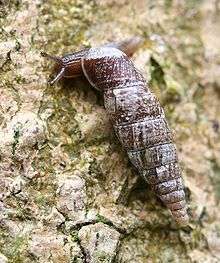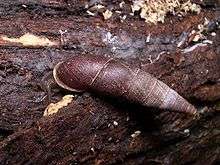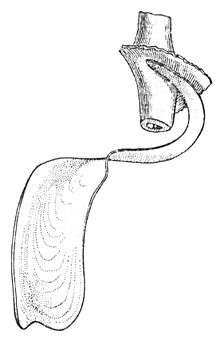Clausiliidae
| Clausiliidae | |
|---|---|
 | |
| Cochlodina laminata | |
| Scientific classification | |
| Kingdom: | Animalia |
| Phylum: | Mollusca |
| Class: | Gastropoda |
| (unranked): | clade Heterobranchia
clade Euthyneura |
| Superfamily: | Clausilioidea |
| Family: | Clausiliidae J. E. Gray, 1855[1] |
| Type genus | |
| Clausilia | |
Clausiliidae, also known by their common name the door snails, are a taxonomic family of small, very elongate, mostly left-handed, air-breathing land snails, sinistral terrestrial pulmonate gastropod mollusks.
With about 1,300 species recent and fossil, this belong among the most diverse families of land gastropods (cf. Orthalicidae, although the marine gastropod family Pyramidellidae is larger).
Most species of Clausiliidae have an anatomical structure known as a clausilium, which enables the snail to close off the aperture of the shell with a sliding "door".
Shell description

Almost all the species of snails in the family of door snails are left-handed, which is an uncommon feature in gastropod shells in general.
These snails have shells which are extremely high-spired, with numerous whorls.
The shells tend to be club-shaped, tapering at both ends to a rounded nub. The aperture usually has visible folds.
The clausilium

Clausiliids are also very unusual among pulmonate gastropods in that most of them have a "door" or clausilium. The clausilium is not the same thing as an operculum, which does not exist at all in pulmonate gastropods.
The clausilium is a calcareous structure, tongue-shaped or spoon-shaped, which can close the aperture of the snail shell to protect the soft parts against predation by animals such as carnivorous beetle larvae. The narrow end of the clausilium slides in the grooves that are formed by the folds on the inside of the shell.
Anatomy
In this family, the number of haploid chromosomes lies between 21 and 30 (according to the values in this table).[2]
Taxonomy
The type genus is Clausilia Draparnaud, 1805.
The Clausiliidae family is classified within the informal group Sigmurethra, itself belonging to the clade Stylommatophora within the clade Eupulmonata (according to the taxonomy of the Gastropoda by Bouchet & Rocroi, 2005).[3]
2005 taxonomy
The taxonomy of the Gastropoda by Bouchet & Rocroi, 2005 recognizes subfamilies as follows:
subfamily Clausiliinae Gray, 1855
- tribe Clausiliini Gray, 1855 - synonym: Fusulinae Lindholm, 1924
- tribe Gracillariini H. Nordsieck, 1979
subfamily Alopiinae A. J. Wagner, 1913
- tribe Alopiini A. J. Wagner, 1913
- tribe Cochlodinini Lindholm, 1925 (1923) - synonym: Marpessinae Wenz, 1923
- tribe Delimini Brandt, 1956 - synonym: Papilliferini Brandt, 1961 (n.a.)
- tribe Medorini H. Nordsieck, 1997
- tribe Montenegrinini H. Nordsieck, 1972
subfamily Baleinae A. J. Wagner, 1913 - synonyms: Laciniariini H. Nordsieck, 1963; Tristaniinae Schileyko, 1999
subfamily † Constrictinae H. Nordsieck, 1981[4]
subfamily Garnieriinae C. Boettger, 1926
- tribe Garnieriini C. Boettger, 1926
- tribe Tropidaucheniini H. Nordsieck, 2002
subfamily † Eualopiinae H. Nordsieck, 1978
subfamily Laminiferinae Wenz, 1923
subfamily Mentissoideinae Lindholm, 1924
- tribe Mentissoideini Lindholm, 1924 - synonym: Euxininae I. M. Likharev, 1962
- tribe Acrotomini H. Nordsieck, 1979
- tribe Boettgeriini H. Nordsieck, 1979
- tribe Euxinellini Neubert, 2002
- tribe Filosini H. Nordsieck, 1979
- tribe Olympicolini Neubert, 2002
- tribe Strigileuxinini H. Nordsieck, 1994
- tribe Strumosini H. Nordsieck, 1994
subfamily Neniinae Wenz, 1923 - Neniastrinae H. B. Baker, 1930
subfamily Phaedusinae A. J. Wagner, 1922
- tribe Phaedusini A. J. Wagner, 1922
- tribe Megalophaedusini Zilch, 1954 - synonym: Zaptyxini Zilch, 1954
subfamily Serrulininae Ehrmann, 1927
Genera
Genera include:
Clausiliinae
tribe Clausiliini
- Clausilia Draparnaud, 1805 - with two subgenera: Clausilia and Strobeliella H. Nordsieck, 1977[7]
- Erjavecia Brusina, 1870[7]
- Fusulus Fitzinger, 1833 - with two subgenera: Erjaveciella H. Nordsieck, 1877 and Fusulus[7]
- Julica H. Nordsieck, 1963[7]
- Macrogastra Hartmann, 1841 - with three subgenera: Macrogastra, Pseudovestia H. Nordsieck, 1877 and Pyrostoma Vest, 1867[7]
- Micridyla H. Nordsieck, 1973[7]
- Neostyriaca A. J. Wagner, 1920[7]
- Pseudofusulus H. Nordsieck, 1977 - has the only one species: Pseudofusulus varians[7]
- Ruthenica Lindholm, 1924[7]
tribe Gracillariini
- Graciliaria Bielz, 1867[8]
Alopiinae
Alopiinae[9]
tribe Alopiini
- Alopia H. & A.Adams, 1855 - with two subgenera Alopia and Kimakowiczia Szekeres, 1969
- Herilla H. & A. Adams, 1855
- Triloba Vest, 1867
tribe Cochlodinini
- Cochlodina A. Férussac, 1821 - with four subgenera: Cochlodina; Cochlodinastra H. Nordsieck, 1977; Paracochlodina H. Nordsieck, 1969; Procochlodina H. Nordsieck, 1969
- Macedonica O. Boettger, 1877
tribe Delimini
- Barcania Brandt, 1956
- Charpentieria Stabille, 1864 - with four subgenera: Charpentieria; Gibbularia Monterosato, 1908; Mauritanica O. Boettger, 1877; Siciliaria Vest, 1867 and Stigmatica O. Boettger, 1877
- Delima Hartmann, 1842 - with four subgenera: Delima; Dugiana Stamol & Slapnik, 2002; Piceata O. Boettger, 1877 and Semirugata O. Boettger, 1877
- Dilataria Vest, 1867
- Papillifera Hartmann, 1842
tribe Medorini H. Nordsieck, 1997
- Agathylla H. & A.Adams, 1855 - with two subgenera Agathylla and Agathyllina H. Nordsieck, 1969
- Albinaria Vest, 1867 - also include former genera Carinigera Moellendorff, 1873; Cristataria Vest, 1867; Isabellaria Vest, 1867; Sericata O. Boettger, 1878.
- Inchoatia Gittenberger & Uit de Weerd, 2006[10]
- Lampedusa - with two subgenera Imitatrix Westerlund, 1884 and Lampedusa
- Leucostigma A. J. Wagner, 1919
- Medora H. & A. Adams, 1855
- Muticaria Lindholm, 1925
- Strigilodelima A. J. Wagner, 1924
tribe Montenegrinini
- Montenegrina O. Boettger, 1877
- Protoherilla A. J. Wagner, 1921
Baleinae
- Alinda H. & A. Adams, 1855 - with two subgenera: Alinda and Pseudalinda O. Boettger, 1877
- Balea J. E. Gray, 1824
- Bulgarica O. Boettger, 1877 - with three subgenera Bulgarica, Pavlovicia H. Nordsieck, 1973 and Strigilecula Kennard & Woodward, 1923
- Lacinaria Hartmann, 1842
- Likharevia H. Nordsieck, 1975
- Menissa H. & A.Adams, 1855
- Mentissella H. Nordsieck, 1973
- Micropontica O. Boettger, 1881 - with two subgenera: Baleopsina Lindholm, 1924 and Micropontica
- Mucronaria O. Boettger, 1877 - with two subgenera: Index O. Boettger, 1877 and Mucronaria
- Quadriplicata O. Boettger, 1878
- Vestia Hesse, 1916 - with three subgenera: Brabenecia H. Nordsieck, 1974; Vestia and Vestiella H. Nordsieck, 1877
Constrictinae
Fossil subfamily Constrictinae contains genera:
- † Constricta O. Boettger, 1877 - type genus of the subfamily[3]
Garnieriinae
- Garnieria Bourguignat, 1877
- Grandinenia Minato & Chen, 1984
- Indonenia Ehrmann, 1927
- Megalauchenia H. Nordsieck, 2007
- Neniauchenia H. Nordsieck, 2002
- Tropidauchenia Lindholm, 1924 - with two subgenera: Euryauchenia H. Nordsieck, 2007 and Tropidauchenia
Eualopiinae
Fossil subfamily Eualopiinae contains genera:
tribe † Eualopiini
- † Eualopia O. Boettger, 1877 - type genus of the subfamily[3]
tribe † Rillyini
- † Rillya Munier-Chalmas [in P. Fischer], 1883 - type genus of the tribe[3]
Laminiferinae
- Laminifera O. Boettger, 1863 - the type genus of the family Laminiferinae.[3] Its type species is fossil.[3] (Actual status of the genus?)
- Bofilliella Ehrmann, 1927
- Neniatlanta Bouguignat, 1876
Mentissoideinae
- Acrotoma O. Boettger, 1881 - with four subgenera: Acrotoma, Acrotomina H. Nordsieck, 1977; Bzybia H. Nordsieck, 1977 and Castelliana Suvorov, 2002
- Akramowskia H. Nordsieck, 1975
- Armenica O. Boettger, 1877 - with two subgenera: Armenica and Astrogena Szekeres, 1970
- Bitorquata O. Boettger, 1877
- Boettgeria O. Boettger, 1863 - with two subgenera: Boettgeriaand Loosjesiella Neubert & Groh, 1998
- Elia H. & A.Adams, 1855 - with four subgenera: Acroeuxina O. Boettger, 1877; Caucasica O. Boettger, 1877; Elia and Megaleuxina O. Boettger, 1877
- Euxina O. Boettger, 1877 - with two subgenera: Euxina and Illunellaria Lindholm, 1924
- Euxinastra O. Boettger, 1888 - with two subgenera: Euxinastra and Odonteuxina H. Nordsieck, 1875
- Euxinella H. Nordsieck, 1973
- Filosa O. Boettger, 1877
- Galeata O. Boettger, 1877
- Idyla H. & A. Adams, 1855 - with two subgenera: Idyla and Strigilidyla H. Nordsieck, 1994
- Kazancia Neubert, 1992 - with two subgenera: Kazancia and Lasica Neubert, 1995
- Macroptychia O. Boettger, 1877
- Mentissoidea O. Boettger, 1877
- Olympicola Hesse, 1916
- Phrygica H. Nordsieck, 1994
- Roseniella Thiele, 1931 - with two subgenera: Chavchetia Neubert, 1992 and Roseniella
- Sabaeola Lindholm, 1925
- Sprattia O. Boettger, 1883
- Strigileuxina H. Nordsieck, 1975
- Strumosa O. Boettger, 1877
- Sumelia H. Nordsieck, 1994
Neniinae
- Andinia Polinski, 1922
- Andiniella Weyrauch, 1958
- Audiniastra H. Nordsieck, 2005
- Bequaertinenia Weyrauch, 1964 - with two subgenera: Bequaertinenia and Miranenia Grego & Szekeres, 2004
- Brevinenia Neubert & H. Nordsieck, 2005
- Columbinia Polinski, 1924 - with three subgenera: Columbinia; Paranenia Rehder, 1939 and Steatonenia Pilsbry, 1926
- Cyclonenia H. Nordsieck, 1999
- Cylindronenia Ehrmann in Pilsbry, 1949 - with two subgenera: Cylindronenia and Cylindroneniella H. Nordsieck, 2007
- Ehrmanniella Zilch, 1949
- Gonionenia Pilsbry, 1926
- Gracilinenia Polinski, 1922
- Hemicena Pilsbry, 1949
- Incaglaia Pilsbry, 1949 - with two subgenera: Gibbonenia Zilch, 1954 and Incaglaia
- Incania Polinski, 1922
- Leuconenia H. Nordsieck, 2005
- Nenia H. & A. Adams, 1855
- Neniaptyx H. Nordsieck, 2007
- Neniatracta Pilsbry, 1926
- Neniella Grego & Sekeres, 2004
- Neniops Pilsbry, 1926
- Nenisca Rehder, 1939
- Parabalea Ancey, 1882
- Peruinia Polinski, 1922
- Pfeifferiella Weyrauch, 1957
- Pseudogracilinenia Loosjes & Loosjes-van Bemmel, 1984
- Steeriana Jousseaume, 1900
- Symptychiella H. Nordsieck, 1999 - with two subgenera: Divnenia H. Nordsieck, 2005 and Symptychiella
- Temesa H. & A. Adams, 1855
- Zilchiella Weyrauch, 1957
Phaedusinae
tribe Phaedusini
- Phaedusa H. & A.Adams, 1855 - with four subgenera: Metaphaedusa H. Nordsieck, 2001; Phaedusa; Pseudophaedusa Tomiyama, 1984 and Stereophaedusa O. Boettger, 1877
tribe Megalophaedusini
- Leptacme Ehrmann, 1927[11]
- Oospira Blanford, 1872[11] - with five subgenera: Atractophaedusa Ehrmann, 1927; Formosana O. Boettger, 1877; Formosanella H. Nordsieck, 2003; Oospira; Paraformosella H. Nordsieck, 2003 and Siphonophaedusa Lindholm, 1924
- Zaptyx Pilsbry, 1901 - with two subgenera: Prozaptyx Loosjes, 1950 and Zaptyx
tribe ?
- Acanthophaedusa H. Nordsieck, 2007
- Bathyptychia Lindholm, 1925 - with three subgenera: Bathyptychia; Brachyptychia H. Nordsieck, 2001 and Strictiphaedusa H. Nordsieck, 2001
- Celsiphaedusa H. Nordsieck, 2001
- Cylindrophaedusa O. Boettger, 1877 - with three subgenera: Cylindrophaedusa and Montiphaedusa H. Nordsieck, 2002
- Dautzenbergiella Lindholm, 1924 - with two subgenera: Dautzenbergiella and Mansuyiella H. Nordsieck, 2003
- Diceratoptyx Pilsbry, 1905
- Euphaedusa O. Boettger, 1877 - with five subgenera: Dentiphaedusa H. Nordsieck, 2003; Euphaedusa; Papilliphaedusa H. Nordsieck, 2003; Tauphaedusa H. Nordsieck, 2003 and Telophaedusa H. Nordsieck, 2003
- Fuchsiana Gredler, 1887
- Hemiphaedusa O. Boettger, 1877 - with 10 subgenera: Dendrophaedusa H. Nordsieck, 2002; Hemiphaedusa; Hemiphaedusoides H. Nordsieck, 2001; Hemizaptyx Pilsbry, 1905; Labyrinthiphaedusa H. Nordsieck, 2001; Margaritiphaedusa H. Nordsieck, 2001; Notoptychia Ehrmann, 1927; Pinguiphaedusa Azuma, 1982; Placeophaedusa Minato, 1994 and Selenophaedusa Lindholm, 1924
- Heterozaptyx Pilsbry, 1906
- Juttingia Loosjes, 1965 - with two subgenera: Juttingia and Pseudohemiphaedusa H. Nordsieck, 2002
- Lindholmiella Ehrmann, 1927
- Liparophaedusa Lindholm, 1924
- Loosjesia H. Nordsieck, 2002
- Luchuphaedusa Pilsbry, 1901 - with two subgenera: Luchuphaedusa and Nesiophaedusa Pilsbry, 1905
- Macrophaedusa Moellendorff, 1883
- Macrophaedusella H. Nordsieck, 2001
- Megalophaedusa O. Boettger, 1877 - with four subgenera: Megalophaedusa; Mesophaedusa Ehrmann, 1929; Mesozaptyx Kuroda, 1963 and Mundiphaedusa Minato, 1979. (Neophaedusa is a synonym of Megalophaedusa).[12]
- Metazaptyx Pilsbry, 1905
- Miraphaedusa H. Nordsieck, 2005
- Oligozaptx Pilsbry, 1905
- Paraphedusa O. Boettger, 1877
- Parazaptyx Pilsbry, 1905
- Pliciphaedusa H. Nordsieck, 1998
- Pulchraptyx Minato, 1981
- Reinia Kobelt, 1876 - with three subgenera: Parareinia H. Nordsieck, 1998; Pictophaedusa Azuma, 1982 and Reinia
- Renschiphaedusa Loosjes & Loosjes-van Bemmel, 1973
- Selenoptyx Pilsbry, 1908
- Serriphaedusa H. Nordsieck, 2001
- Sinigena Lindholm, 1925
- Stereozaptyx Pilsbry, 1905
- Streptodera Lindholm, 1925
- Synprosphyma Germain, 1919 - with two subgenera; Excussispira Lindholm, 1925 and Synprosphyma
- Thaumatoptyx Pilsbry, 1908
- Tyrannophaedusa Pilsbry, 1901 - with two subgenera: Aulacophaedusa Azuma, 1982 and Tyrannophaedusa
- Tyrannozaptyx Käufel, 1930
- Zaptychopsis Ehrmann, 1927
Serrulininae
- Caspiophaedusa Lindholm, 1924
- Dobatia H. Nordsieck, 1973
- Graecophaedusa Rähle, 1982
- Laeviphaedusa Likharev & Stelkov, 1965
- Microphaedusa H. Nordsieck, 1978
- Nothoserrulina Németh & Szekeres, 1995
- Pamphylica Németh & Szekeres, 1995
- Pravispira Lindholm, 1924
- Pontophaedusa Lindholm, 1924
- Pontophaedusella H. Nordsieck, 1994
- Sciocochlea C. Boettger, 1935
- Serrulina Mousson, 1873
- Serrulinella H. Nordsieck, 1984
- Truncatophaedusa Majoros, Németh & Szili-Kovács 1994
- Tsoukatosia Gittenberger, 2000 - with two subgenera: Agiosspeleikos A. & P. Reischütz, 2003 and Tsoukatosia
Conservation
Although non-marine molluscs appear to be exceptionally vulnerable to extinction,[13] the IUCN Red list listed only 9 species[14] from this family.
References
- ↑ J. E. Gray. April 14, 1855. Catalogue of Pulmonata or air-breathing Mollusca in the collection of the British Museum, Part I: 156.
- ↑ Barker G. M.: Gastropods on Land: Phylogeny, Diversity and Adaptive Morphology. in Barker G. M. (ed.): The biology of terrestrial molluscs. CABI Publishing, Oxon, UK, 2001, ISBN 0-85199-318-4. 1-146, cited pages: 139 and 142.
- 1 2 3 4 5 6 Bouchet P.; Rocroi J.-P.; Frýda J.; Hausdorf B.; Ponder W.; Valdés Á. & Warén A. (2005). "Classification and nomenclator of gastropod families". Malacologia: International Journal of Malacology. Hackenheim, Germany: ConchBooks. 47 (1-2): 1–397. ISBN 3-925919-72-4. ISSN 0076-2997.
- ↑ Nordsieck H. (1981). Archiv für Molluskenkunde 111(1-3): 101.
- ↑ Nordsieck H. (1978). Archiv für Molluskenkunde 109(1-3): 104.
- ↑ Nordsieck H. (1985). Heldia 1(3): 83.
- 1 2 3 4 5 6 7 8 9 "Clausiliini". Fauna Europaea, last update 27 January 2011, accessed 27 April 2011.
- ↑ "Graciliaria". Fauna Europaea, last update 27 January 2011, accessed 27 April 2011.
- ↑ Uit de Weerd D. R. (2004). "Molecular phylogenetic history of eastern Mediterranean Alopiinae, a group of morphologically indeterminate land snails". Doctoral thesis, Leiden University, ISBN 90-6464-874-3.
- ↑ Gittenberger E. & Uit de Weerd D. R. (2009). "Summarizing data on the Inchoatia taxa, including Inchoatia megdova bruggeni subspec. nov. (Gastropoda, Pulmonata, Clausiliidae)" Zoologische Mededelingen 83 http://www.zoologischemededelingen.nl/83/nr03/a08
- 1 2 Maassen W. J. M. & Gittenberger E. (2007). "Three new clausiliid land snails from Tonkin, northern Vietnam (Gastropoda: Pulmonata: Clausiliidae)". Zoologische Mededelingen 81(1): http://www.zoologischemededelingen.nl/81/nr01/a10
- ↑ cf. Nordsieck H. (2006). "Species list of recent Clausiliidae".
- ↑ Lydeard, C.; Cowie R.; Ponder, W.F.; et al. (April 2004). "The global decline of nonmarine mollusks" (PDF). BioScience. 54: 321–330. doi:10.1641/0006-3568(2004)054[0321:TGDONM]2.0.CO;2. Archived from the original (PDF) on 31 March 2007. Retrieved 20 Oct 2009.
- ↑ IUCN 2009. IUCN Red List of Threatened Species. Version 2009.2. <www.iucnredlist.org>. Downloaded on 5 March 2010.
Further reading
- Maltz T. K. & Sulikowska-Drozd A. (2008) "Life Cycles of Clausiliids of Poland — Knowns and Unknowns". Annales Zoologici 58(4): 857-880. doi:10.3161/000345408X396783.
- Nordsieck H. (2007). Worldwide Door Snails. ConchBooks, 213 pp. ISBN 978-3-939767-07-7.
- Uit de Weerd D. R. (2004). "Molecular phylogenetic history of eastern Mediterranean Alopiinae, a group of morphologically indeterminate land snails". Doctoral thesis, Department of Biology, Faculty of Science, Leiden University. HTM, PDF.
- Uit de Weerd D. R., Piel W. H. & Gittenberger E. (2004). "Widespread polyphyly among Alopiinae snail genera: when phylogeny mirrors biogeography more closely than morphology". Molecular Phylogenetics and Evolution 33(3): 533-548. doi:10.1016/j.ympev.2004.07.010
External links
| Wikimedia Commons has media related to Clausiliidae. |
- Nordsieck H. (2005–2007). www.clausilia.de at Internet Archive.
- Nordsieck H.: http://www.hnords.de: Internet journal for the malacology of landsnails (with special regard to Clausiliidae).
- BioLib info